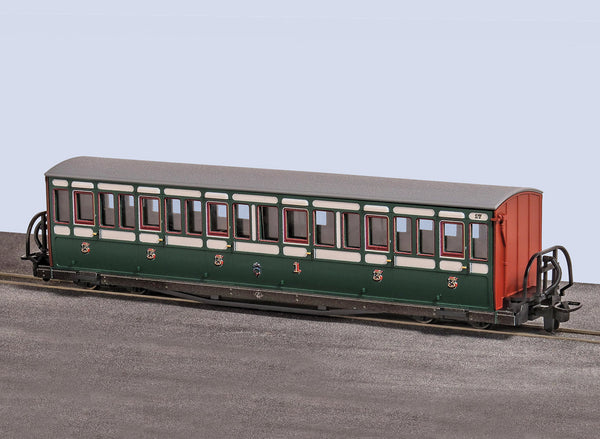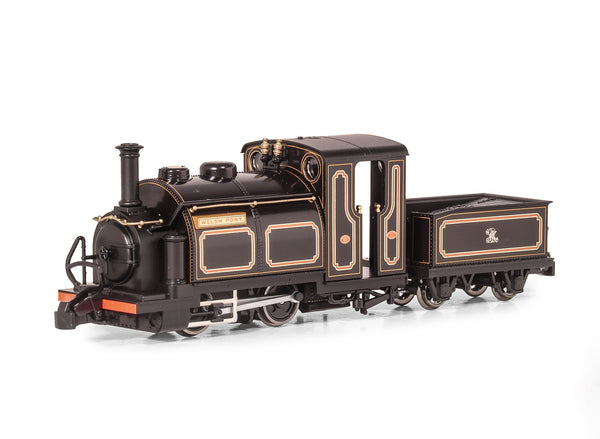DURCHSUCHEN SIE PECO-PRODUKTE
Stöbern Sie durch unser komplettes Produktportfolio.
41 Products Found
FR Short 'Bowsider' Bogie Coach - Early Preservation - Green 17
FR Short 'Bowsider' Bogie Coach - Early Preservation - Green 18
FR Short 'Bowsider' Bogie Coach - Early Preservation - Green 19
FR Short 'Bowsider' Bogie Coach - Early Preservation - Green 20
OO-9 Center Observation Coach Lynton und Barnstaple Livery Nr. 7
Diese fein detaillierten, fahrbereiten Waggons und Waggons sind genau dem rollenden Material der Lynton and Barnstaple Railway nachempfunden, sowohl als eigenständige Eisenbahn als auch nach deren Eingliederung in die Southern Railway im Jahr 1922. Sie sind für diese Modellbauer auch bemalt, aber unbeschriftet erhältlich die sie für den Einsatz auf anderen Linien anpassen möchten.
OO-9 Center Observation Coach Lynton und Barnstaple Livery Nr. 10
Diese fein detaillierten, fahrbereiten Waggons und Waggons sind genau dem rollenden Material der Lynton and Barnstaple Railway nachempfunden, sowohl als eigenständige Eisenbahn als auch nach deren Eingliederung in die Southern Railway im Jahr 1922. Sie sind für diese Modellbauer auch bemalt, aber unbeschriftet erhältlich die sie für den Einsatz auf anderen Linien anpassen möchten.
Kreuzung, Doppelrutsch
Doppelschleusen können wertvollen Platz an Bahnhofsvorfahrten, Kreuzungen usw. sparen und sind bei europäischen Eisenbahnen weit verbreitet.
Dieses 12-mm-Gleissystem ist in H0 genau nach dem Vorbild der in Europa, insbesondere in der Schweiz, verbreiteten Meterspurgleise gestaltet. Es ist auch nützlich für die Modellierung der 3 Fuß 6 Zoll langen Strecke, die im südlichen Afrika, Japan, Australien, Norwegen und Teilen Südamerikas zu finden ist; Im 4-mm-Maßstab entspricht die Spurweite den vielen Linien mit einer Spurweite von 3 Fuß, die früher in Irland und auf der Isle of Man zu finden waren. Diese vielseitige Schiene kann auch für den Modellbau im TT-Bereich (Maßstab 3 mm/ft) verwendet werden.
OO-9 Kleine englische PECO/KATO-Lokomotive – „Prince“
Bewundern Sie die brandneue Ffestiniog Railway Small England 0-4-0ST+T-Lokomotive „Prince“, die gemeinsam von PECO und dem bekannten japanischen Modelleisenbahnhersteller Kato produziert wurde.
Ausgeführt als „Prinzessin“ Nr. 1 und „Prinz“ Nr. 2, beide in kastanienbrauner Lackierung mit historischem Ffestiniog-Eisenbahn-Design.
OO-9 Kleine englische PECO/KATO-Lokomotive – „Prince“
Bewundern Sie die brandneue Ffestiniog Railway Small England 0-4-0ST+T-Lokomotive „Prince“, die gemeinsam von PECO und dem bekannten japanischen Modelleisenbahnhersteller Kato produziert wurde.
Ausgeführt als „Prinzessin“ Nr. 1 und „Prinz“ Nr. 2, beide in kastanienbrauner Lackierung mit historischem Ffestiniog-Eisenbahn-Design.
OO-9 Kleine englische PECO/KATO-Lokomotive – „Prince“
Bewundern Sie die brandneue Ffestiniog Railway Small England 0-4-0ST+T-Lokomotive „Prince“, die gemeinsam von PECO und dem bekannten japanischen Modelleisenbahnhersteller Kato produziert wurde.
Ausgeführt als „Prinzessin“ Nr. 1 und „Prinz“ Nr. 2, beide in kastanienbrauner Lackierung mit historischem Ffestiniog-Eisenbahn-Design.
OO-9 Kleine englische PECO/KATO-Lokomotive – „Prince“
Bewundern Sie die brandneue Ffestiniog Railway Small England 0-4-0ST+T-Lokomotive „Prince“, die gemeinsam von PECO und dem bekannten japanischen Modelleisenbahnhersteller Kato produziert wurde.
Ausgeführt als „Prinzessin“ Nr. 1 und „Prinz“ Nr. 2, beide in kastanienbrauner Lackierung mit historischem Ffestiniog-Eisenbahn-Design.
GWR-Bahnhofsgebäude aus Holz (Monkton Combe)
Monkton Combe, einst eine Zwischenstation der lange geschlossenen Camerton-Filiale in der Nähe von Bath, rückte 1952 ins Rampenlicht, als es als Drehort für die berühmte Ealing-Komödie „The Titfield Thunderbolt“ ausgewählt wurde.


















